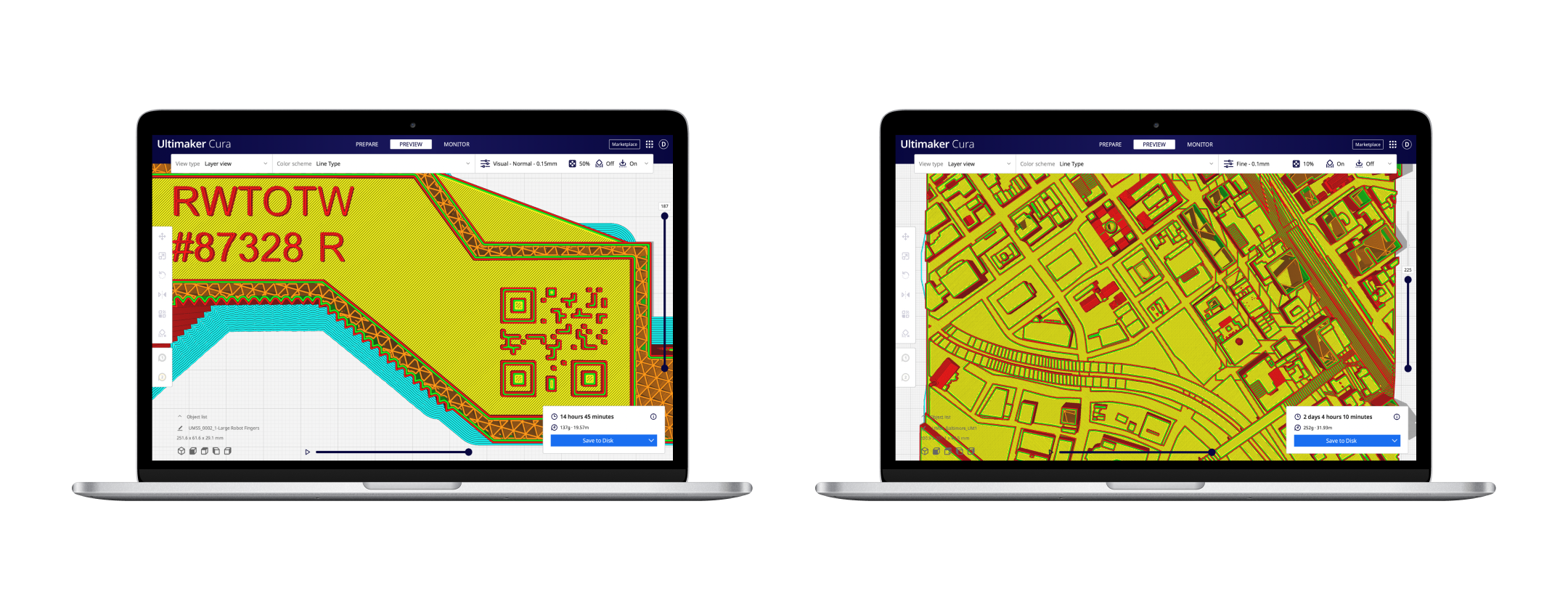Ultimaker has just announced the release of the beta version for Cura 5.0, the latest edition of its widely-used, open-source slicing software. The company revealed the new upgrade at this year’s Ultimaker Showcase, and is touting Cura 5.0 as “the biggest leap forward in print quality that the software has ever seen.”
Ultimaker specializes in fused filament fabrication (FFF) technology, and makes some of the world’s most popular desktop 3D-printers, including the Ultimaker 2+. The prevalence of its products, combined with an open-source — and free — operating system, attribute a significance to Ultimaker’s actions that goes far beyond the scope of just one company. In other words, the changes Ultimaker effects can surely be expected to change the industry, as a whole.
In this vein, the biggest upgrade ushered in by Cura 5.0 involves the user’s ability to control the line width of 3D models. On its face this may sound like a minor tweak, but in practice, it in fact addresses a highly significant limitation to FFF 3D-printers. Without this capability, users can only change the line width of FFF prints by changing the print head nozzle, yielding a print with identical line widths across the object’s entirety. The main obstacle this presents for the user is that, if a portion of the print is designed to be two-and-a-half lines thick, only two lines are printed. A small empty space, representing the remaining half-a-line, is left in the middle of the two lines. Thus, any attempt to create details between the one-line thresholds can only be achieved by leaving gaps in the final product.

As a result, one of the biggest advantages to the increase in user control — and decrease in gaps — that Cura 5.0 facilitates is a stronger end-product. As Steve Cox, an engineer and 3D printing consultant who has already used this latest Cura update puts it, “…fewer limitations have to be considered in CAD, so the software is less of a limiting factor towards the end result. Thin walls, and the kind of small design features that are often featured in injection molded parts, are created much more efficiently…”

Other features of the newest update mostly entail similar, gradual improvements that have been part of previous updates. These include an improved user interface, faster print profiles for users of Ultimaker printers (yielding print time reductions of up to 20%), and better integration between Cura and Ultimaker Marketplace — a sort of app store where users can get continuously updated plug-ins for the Cura software. Finally, one additional, novel feature of Cura 5.0, is that it has been designed specifically with products that use Apple M1 chips in mind.
However, the biggest improvement is variable line width. The aforementioned special influence Ultimaker has in the industry, if only due to its being so pervasive, will be proven by how quickly this feature spreads to other FFF operating systems and machines. Moreover, it’s likely that this initial step will have a ripple effect on the evolution of printer head control in the sector.
Images courtesy of Ultimaker
Subscribe to Our Email Newsletter
Stay up-to-date on all the latest news from the 3D printing industry and receive information and offers from third party vendors.
Print Services
Upload your 3D Models and get them printed quickly and efficiently.
You May Also Like
Making 3D Printing Personal: How Faraz Faruqi Is Rethinking Digital Design at MIT CSAIL
What if your 3D printer could think more like an intelligent assistant, able to reason through a design idea, ask questions, and deliver something that works exactly the way the...
Reinventing Reindustrialization: Why NAVWAR Project Manager Spencer Koroly Invented a Made-in-America 3D Printer
It has become virtually impossible to regularly follow additive manufacturing (AM) industry news and not stumble across the term “defense industrial base” (DIB), a concept encompassing all the many diverse...
Heating Up: 3D Systems’ Scott Green Discusses 3D Printing’s Potential in the Data Center Industry
The relentless rise of NVIDIA, the steadily increasing pledges of major private and public investments in national infrastructure projects around the world, and the general cultural obsession with AI have...
Formlabs Teams Up with DMG MORI in Japan
In late June, Nick Graham, Chief Revenue Officer at Formlabs, announced on LinkedIn that the company had partnered with DMG MORI, one of the world’s leading machine tool companies, to...

































